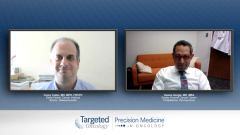
The Promising Future of GVHD Management
Expert physicians consider how ongoing developments will impact the treatment paradigm of graft-vs-host disease.
Episodes in this series

Corey Cutler, MD, MPH, FRCPC: What do you think the next big questions are in acute graft-vs-host disease [GVHD]? After that, we’ll talk about some data from the upcoming ASH [American Society of Hematology Annual Meeting].
Usama Gergis, MD, MBA: In my mind, there are 2 big questions. The first question is: What’s after second line? Right now, ruxolitinib is the second line. Most patients will either not respond or respond and lose that response. What’s next? Can you add something to ruxolitinib? Can you do something else afterward? When patients reach that point, their 100-day survival is very dismal, so that’s a big question. I don’t think I have an answer, and I’m not sure I will in my lifetime.
The second big question is: How about if we try to do a better job at prophylaxis and preventing acute GVHD in the first place? One of my previous ex-mentors told me, “Good luck.” After 15 years, I think he’s probably half-correct. After 15 years, we have the JAK-STAT pathways, but they still don’t work 75% of the time.
Corey Cutler, MD, MPH, FRCPC: However, I’ll disagree with your former mentor, who will be nameless. We’re at an interesting point in our field where there is real interest in drug development and there are lots of agents that are being developed and tested. It’s probably important to highlight some of those other agents. The BMT CTN [Blood and Marrow Transplant Clinical Trials Network] is doing a large randomized trial of alpha-1 antiprotease or alpha-1 antitrypsin in steroid-refractory disease, and that has shown at least some preliminary promise in phase 2 trials. They’re also doing a second smaller trial using a double-antibody conjugate—an anti-CD3, anti-CD7 conjugate—that’s conjugated to ricin. That trial has stuttered a little, but my understanding is it might get back up and running again. Mesenchymal stem cells are coming back and going to be studied formally again. There are also the drugs that prevent T-cell trafficking. Vedolizumab and natalizumab are being tested actively, particularly for patients with GI [gastrointestinal] GVHD.
Then there’s a nondepleting anti-CD6 antibody called ibalizumab. It’s being tested in a multicenter fashion as initial therapy for acute GvHD. There is at least some optimism in the field that we might be going somewhere. It would be great if we can go somewhere good with all these new drugs. I do agree with you that prophylaxis is ultimately going to be the answer. There’s a ton of activity in the prophylactic space as well. Even if one takes away all the activity with post-transplant cyclophosphamide, which is good at preventing chronic GVHD but not so good at preventing acute GVHD, people are learning different strategies beyond that. The Fate [Therapeutics, Inc] stem cell reprogramming trial will be reading out soon. There is a worldwide phase 3 trial looking at vedolizumab. We have the costimulatory blockade activity with abatacept and other costimulatory blockers that are being tested. There might actually be some light on the horizon. We might be entering a new wave where we’ll be able to prevent a fair bit more graft-vs-host disease moving forward.
Transcript edited for clarity.









































